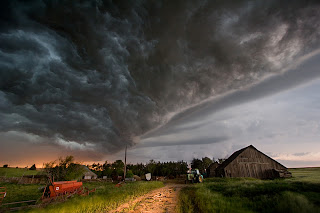Ternado Ternado Ternado Ternado Ternado Ternado Ternado Ternado Ternado
Tornado
From Wikipedia, the free encyclopedia
This article is about the weather phenomenon. For other uses, see Tornado (disambiguation).
For the current tornado season, see Tornadoes of 2012.
A tornado near Anadarko, Oklahoma. The funnel itself is the thin tube reaching from the cloud to the ground. The lower part of this tornado is surrounded by a translucent dust cloud, kicked up by the tornado's strong winds at the surface. Note that the actual wind of the tornado has a much wider radius than the funnel.
Part of the Nature series on
Weather
Calendar seasons
Spring · Summer
Autumn · Winter
Tropical seasons
Dry season · Wet season
Storms
Thunderstorm · Supercell
Downburst · Lightning
Tornado · Waterspout
Tropical cyclone (Hurricane)
Extratropical cyclone
Winter storm · Blizzard · Ice storm
Dust storm · Firestorm · Cloud
Precipitation
Drizzle · Rain · Snow · Graupel
Freezing rain · Ice pellets · Hail
Topics
Meteorology · Climate
Weather forecasting
Heat wave · Air pollution
Weather portal
v d e
A tornado is a violent, dangerous, rotating column of air that is in contact with both the surface of the earth and a cumulonimbus cloud or, in rare cases, the base of a cumulus cloud. They are often referred to as a twister or a cyclone,[1] although the word cyclone is used in meteorology in a wider sense, to name any closed low pressure circulation. Tornadoes come in many shapes and sizes, but are typically in the form of a visible condensation funnel, whose narrow end touches the earth and is often encircled by a cloud of debris and dust. Most tornadoes have wind speeds less than 110 miles per hour (177 km/h), are approximately 250 feet (76 m) across, and travel a few miles (several kilometers) before dissipating. The most extreme tornadoes can attain wind speeds of more than 300 mph (480 km/h), stretch more than two miles (3.2 km) across, and stay on the ground for dozens of miles (more than 100 km).[2][3][4]
Various types of tornadoes include the landspout, multiple vortex tornado, and waterspout. Waterspouts are characterized by a spiraling funnel-shaped wind current, connecting to a large cumulus or cumulonimbus cloud. They are generally classified as non-supercellular tornadoes that develop over bodies of water.[5] These spiraling columns of air frequently develop in tropical areas close to the equator, and are less common at high latitudes.[6] Other tornado-like phenomena that exist in nature include the gustnado, dust devil, fire whirls, and steam devil.
Tornadoes have been observed on every continent except Antarctica. However, the vast majority of tornadoes in the world occur in the Tornado Alley region of the United States, although they can occur nearly anywhere in North America.[7] They also occasionally occur in south-central and eastern Asia, the Philippines, south east Asia, like Malaysia,[8] northern and east-central South America, Southern Africa, northwestern and southeast Europe, western and southeastern Australia, and New Zealand.[9] Tornadoes can be detected before or as they occur through the use of Pulse-Doppler radar by recognizing patterns in velocity and reflectivity data, such as hook echoes, as well as by the efforts of storm spotters.
There are several different scales for rating the strength of tornadoes. The Fujita scale rates tornadoes by damage caused, and has been replaced in some countries by the updated Enhanced Fujita Scale. An F0 or EF0 tornado, the weakest category, damages trees, but not substantial structures. An F5 or EF5 tornado, the strongest category, rips buildings off their foundations and can deform large skyscrapers. The similar TORRO scale ranges from a T0 for extremely weak tornadoes to T11 for the most powerful known tornadoes.[10] Doppler radar data, photogrammetry, and ground swirl patterns (cycloidal marks) may also be analyzed to determine intensity and assign a rating.[11]
Celeb Wallpaper Pictures Screensaver 3D Movie Poster Postcard Theme Blackground
Search
Sunday, January 29, 2012
Friday, January 27, 2012
Subscribe to:
Posts (Atom)







































































